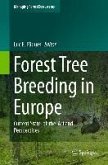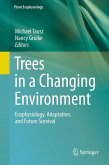For thousands of years, forest biomass or wood has been among the main energy sources of humans around the world. Since the industrial revolution, fossil fuels have replaced wood and become the dominant source of energy. The use of fossil fuels has the disadvantage of increasing atmospheric concentrations of greenhouse gases (GHGs), especially carbon dioxide (CO2), with the consequent warming of global climate and changes in precipitation. In this context, the substitution of fossil fuels with renewable energy sources like forest biomass is among the ways to mitigate climate change.
This book summarizes recent experiences on how to manage forest land to produce woody biomass for energy use and what are the potentials to mitigate climate change by substituting fossil fuels in energy production. In this context, the book addresses how management can affect the supply of energy biomass using short-rotation forestry and the conventional forestry applying long rotations. Furthermore, the book outlines the close interaction between the ecological systems and industrial systems, which controls the carbon cycle between the atmosphere and biosphere. In this context, sustainable forest management is a key to understand and control indirect carbon emissions due to the utilization of forest biomass (e.g. from management, harvesting and logistics, and ecosystem processes), which are often omitted in assessing the carbon neutrality of energy systems based on forest biomass. The focus in this book is on forests and forestry in the boreal and temperate zones, particularly in Northern Europe, where the woody biomass is widely used in the energy industry for producing energy.
This book summarizes recent experiences on how to manage forest land to produce woody biomass for energy use and what are the potentials to mitigate climate change by substituting fossil fuels in energy production. In this context, the book addresses how management can affect the supply of energy biomass using short-rotation forestry and the conventional forestry applying long rotations. Furthermore, the book outlines the close interaction between the ecological systems and industrial systems, which controls the carbon cycle between the atmosphere and biosphere. In this context, sustainable forest management is a key to understand and control indirect carbon emissions due to the utilization of forest biomass (e.g. from management, harvesting and logistics, and ecosystem processes), which are often omitted in assessing the carbon neutrality of energy systems based on forest biomass. The focus in this book is on forests and forestry in the boreal and temperate zones, particularly in Northern Europe, where the woody biomass is widely used in the energy industry for producing energy.
Dieser Download kann aus rechtlichen Gründen nur mit Rechnungsadresse in A, B, BG, CY, CZ, D, DK, EW, E, FIN, F, GR, HR, H, IRL, I, LT, L, LR, M, NL, PL, P, R, S, SLO, SK ausgeliefert werden.









